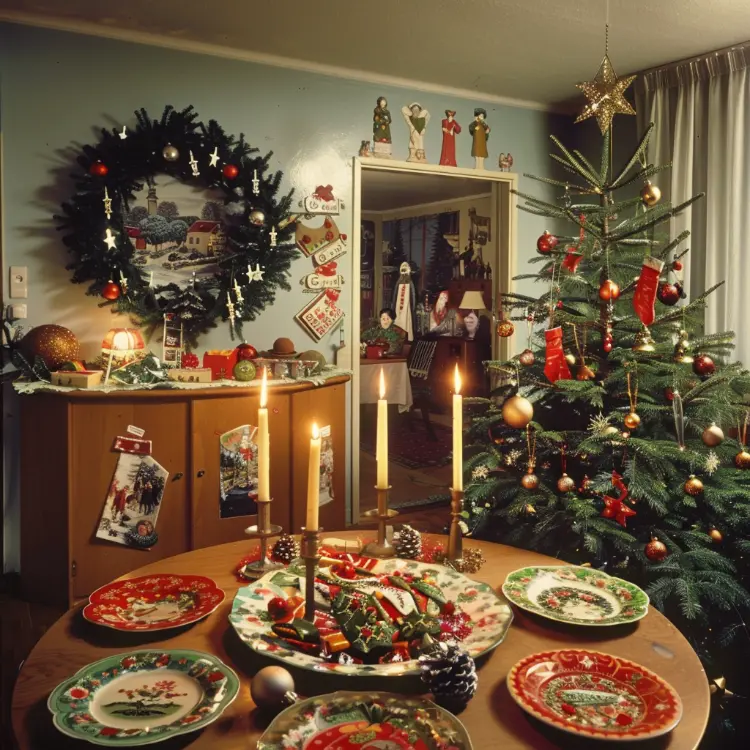With the festive season approaching, it's a time to reflect on the cherished memories and unique traditions that make Christmas special. Each culture has its own way of celebrating, and in Europe, these customs are rich and varied. This article delves into the enchanting traditions of a German Christmas, offering a glimpse into the past and the magic that still lingers today.

Growing up in Germany during the 1970s was a time filled with wonder, especially during the Christmas season. One of the most beloved traditions was the Advent calendar. This picture-box calendar, adorned with wintry scenes and biblical characters, had 24 small doors, each hiding a piece of chocolate. The largest door, opened on December 24th, often contained a chocolate Nativity scene. This daily treat was a highlight for children, marking the countdown to Christmas.
But Advent was more than just the calendar. The Advent wreath, or 'Adventskranz,' was a central part of the celebration. This wreath, decorated with four candles, was displayed on tables throughout the house. Each Sunday before Christmas, a new candle was lit, accompanied by a simple German passage recited by my mother:
"Advent, Advent Ein Kerzlein brennt. Erst eins, dann zwei, dann drei, dann vier - dann steht das Christkind vor der Tür."
This translates to, "Advent, Advent, a candle burns. First one, then two, then three, then four - then stands the Christ Child before the door." In Germany, it is the Christkind (Christ Child) who brings gifts on Christmas Eve.
Another cherished tradition was St. Nicholas Day, celebrated on December 6th. Children eagerly awaited this day, knowing that St. Nicholas, or 'Weinachtsmann,' would visit. In the days leading up to St. Nicholas Day, children had to be on their best behavior, as St. Nicholas was believed to see everything. The night before, we would meticulously clean our winter boots and place them outside our doors. If we had been good, St. Nicholas would fill our boots with candies, small toys, and chocolates. If not, we would find a bundle of switches or lumps of coal.
Interestingly, the modern image of Santa Claus in America was influenced by German-American illustrator Thomas Nast, who created the iconic depiction of Santa that we know today.
In Germany, Christmas celebrations extend beyond December 25th, culminating in 'Heilige Drei Könige Tag,' or Three Kings Day, on January 6th. In regions like Austria, Germany, and Switzerland, the letters C + M + B (Caspar, Melchior, and Balthazar) are inscribed above doorways, symbolizing the Magi and the blessing "Christus mansionem benedicat" (Christ bless this house). This tradition marks the end of the Twelve Days of Christmas.
Christmas Eve, or 'Christkind Abend,' is a night of joy and family gatherings. The Christmas tree, a tradition started by Martin Luther, takes center stage. Families exchange 'Bunte Teller,' or colorful plates filled with oranges, candies, marzipan, gingerbread, stollen (fruit bread), and an assortment of chocolates. Before any gifts are exchanged, Christmas carols like "Stille Nacht" (Silent Night) are sung by the tree, creating a magical atmosphere.
The traditions of a German Christmas have left a lasting impression on me. As a child, the holiday was filled with magic and wonder. As an adult, these beautiful memories are forever etched in my heart and soul. The profound effects of Christmas past continue to shape my appreciation for the season.
Wishing everyone a happy, memory-filled holiday season.
For more insights into European Christmas traditions, visit Deutsche Welle and Germany Travel.
All work by the author is copyright protected. If you would like to use this article, please contact the author for permission.

Programs in Herbal Medicine
".. there are associate degree programs in herbal medicine that teach students the science and nutritional aspects of herbs and healing. Other more generalized studies are introductory in nature, and are typically offered for the home organic gardener or for home-herbal remedies."
Naturopathic Programs - Teaching Principles of Healing
"NDs assume the responsibility of teaching patients to take charge of their health. Furthermore, physicians of naturopathy enable an environment of wellbeing by teaching patients how to take preventive health measures through natural and holistic means."
Programs in Healing Arts
"Students, who are drawn to natural health and holistic healing methods, find that programs in healing arts provide in-depth education and training in the philosophies, practices, and principles of a number of unique health modalities."